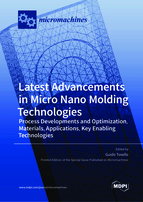Latest Advancements in Micro Nano Molding Technologies – Process Developments and Optimization, Materials, Applications, Key Enabling Technologies
A special issue of Micromachines (ISSN 2072-666X). This special issue belongs to the section "D:Materials and Processing".
Deadline for manuscript submissions: closed (31 December 2020) | Viewed by 69960
Special Issue Editor
Interests: micro- and nanoscale polymer manufacturing; micro- and nanometrology; additive manufacturing; surface replication
Special Issues, Collections and Topics in MDPI journals
Special Issue Information
Dear Colleagues,
Micro and nano molding technologies are continuously being developed due to enduring trends like increasing miniaturization and higher functional integration of products, devices, and systems. Furthermore, with the introduction of higher performance polymers, feedstocks, and composites, new opportunities in terms of materials properties can be exploited, and, consequently, more micro products and micro/nano-structured surfaces are currently being designed and manufactured.
Innovations in micro and nano molding techniques are seen in the different processes employed in production (injection molding, micro injection molding, powder micro molding, two-component molding, compression molding, hot embossing, nanoimprint lithography, etc.); on the use of new and functional materials including, e.g., nanocomposites; for an ever-increasing number of applications (health-care devices, micro implants, mobility, and communications products, optical elements, micro-electromechanical systems, sensors, micro molded interconnect devices, etc.); in several key enabling technologies that support the successful realization of micro and nano molding processes (micro and nano tooling technologies, process monitoring techniques, micro and nanometrology methods for quality control, simulation, rapid prototyping techniques for micro product development, etc.) and their integration into new manufacturing process chains.
Accordingly, this Special Issue seeks to showcase research papers, short communications, and review articles that focus on the latest developments in micro and nanoscale manufacturing by molding techniques as well as their related key enabling technologies for the production of both micro products and micro/nanostructured surfaces.
We look forward to receiving your submissions!
Prof. Guido Tosello
Guest Editor
Manuscript Submission Information
Manuscripts should be submitted online at www.mdpi.com by registering and logging in to this website. Once you are registered, click here to go to the submission form. Manuscripts can be submitted until the deadline. All submissions that pass pre-check are peer-reviewed. Accepted papers will be published continuously in the journal (as soon as accepted) and will be listed together on the special issue website. Research articles, review articles as well as short communications are invited. For planned papers, a title and short abstract (about 100 words) can be sent to the Editorial Office for announcement on this website.
Submitted manuscripts should not have been published previously, nor be under consideration for publication elsewhere (except conference proceedings papers). All manuscripts are thoroughly refereed through a single-blind peer-review process. A guide for authors and other relevant information for submission of manuscripts is available on the Instructions for Authors page. Micromachines is an international peer-reviewed open access monthly journal published by MDPI.
Please visit the Instructions for Authors page before submitting a manuscript. The Article Processing Charge (APC) for publication in this open access journal is 2600 CHF (Swiss Francs). Submitted papers should be well formatted and use good English. Authors may use MDPI's English editing service prior to publication or during author revisions.
Keywords
- molding
- micro products
- micro nano structured surfaces
- tooling
- simulation
- materials
- quality control
- micro rapid prototyping







